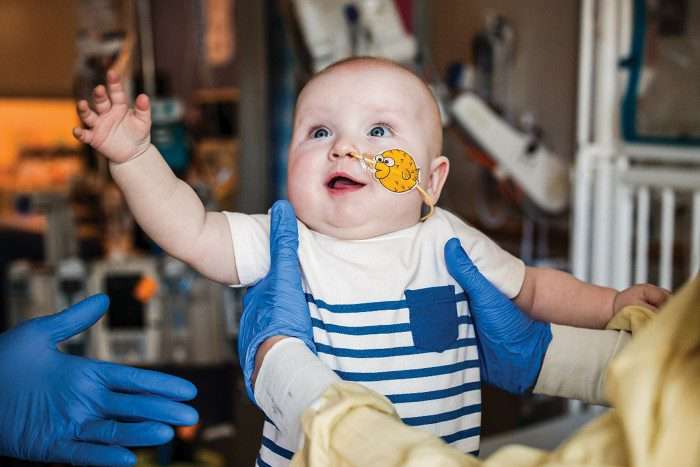
In the first 48 h after K.J. Muldoon’s birth last year, doctors noticed signs of lethargy and respiratory distress. A blood test revealed off-the-charts ammonia levels—they exceeded 1,000 µmol/L, which is far above the 9–33 µmol/L range considered normal. Soon, doctors diagnosed K. J. with a severe form of a rare genetic disorder known as carbamoyl phosphate synthetase 1 (CPS1) deficiency, which affects approximately 1 in 1.3 million people worldwide.
Within 6 months, a team of scientists designed and manufactured a customized CRISPR gene-editing therapy to treat this life-threatening metabolic condition. K. J.—now 9 and a half months old—has received three doses of the therapy and has shown no adverse effects. He’s the first person known to receive a tailor-made gene-editing treatment.
“I don’t think I’m exaggerating when I say that this is the future of medicine,” Kiran Musunuru, a cardiologist and geneticist at the University of Pennsylvaniawho helped develop the therapy for K. J., said at a press briefing on May 12. “My hope is that someday no rare disease patient will die prematurely from misspellings in their genes, because we’ll be able to correct them,” he later added.
Musunuru and his colleagues published details about K. J.’s treatment in a study published May 15 in the New England Journal of Medicine (DOI: 10.1056/NEJMoa2504747). They report that since K. J. received the first dose of his customized therapy in February, he has been able to eat more protein and has needed less ammonia-lowering medication. Rebecca Ahrens-Nicklas, a metabolic physician at Children’s Hospital of Philadelphia and a coauthor of the study, thinks that the gene-editing therapy will turn K. J.’s severe disorder into a milder form. But how long will those changes last? “It’s too early to say,” Ahrens-Nicklas said at the press briefing.
CPS1 deficiency is a urea cycle disorder in which a person lacks a liver enzyme needed to convert ammonia—a by-product of protein breakdown—to urea. This disruption in the conversion causes ammonia to build up to levels that can damage organs such as the liver and brain. Typically, the next suggested step would be a liver transplantation. But “babies must grow big enough to be able to accept a [transplanted] liver,” Ahrens-Nicklas said. Infants could be restricted to a low-protein diet until growing older. But during this wait, “they’re at a very high risk of having episodes of elevated ammonia,” which can result in permanent brain damage and even death, Ahrens-Nicklas added.
The goal of the gene-editing therapy was to repair the faulty gene responsible for producing the CPS1 enzyme. The researchers delivered a corrected version of the CPS1 gene to K. J.’s liver cells via lipid nanoparticles. They first administered a low dose of this therapy in February and subsequently higher doses in March and April—K. J.’s final gene-editing therapy infusion.
The US Food and Drug Administration approved the use of this experimental therapy for K. J. within a week of the research team’s filing the application. “The FDA recognized that this was an unusual circumstance and that K. J. was very, very sick,” Musunuru told reporters. “There wasn’t time for business as usual.”
Although K. J. remains under observation at the Children’s Hospital of Philadelphia, he’s growing well and can roll over and wave, his parents said at the press briefing. Still, Ahrens-Nicklas suspects that K. J. will need to be monitored carefully for the rest of his life. Her team will continue to track his ability to take in protein and his dependence on ammonia-lowering medication. She also acknowledged that the therapy will “probably never be used again,” as it was designed specifically for K. J.’s genetic variants.
Trent Spencer, who is director of the Cell and Gene Therapy Program at the Aflac Cancer and Blood Disorders Center of Children’s Healthcare of Atlanta and wasn’t involved in this work, describes K. J.’s therapy “a pinnacle of personalized medicine.” But he wonders whether future development and deployment of such bespoke therapies will be confined to academic institutions, given the challenges of developing a business model when the number of people with rare diseases is extremely small. Meanwhile, the Accelerating Medicines Partnership Program Bespoke Gene Therapy Consortium, a public-private partnership, is working toward streamlining regulatory requirements and processes to obtain FDA approvals for customized gene-editing therapies for rare diseases.
Source: Chemical and Engineering news






